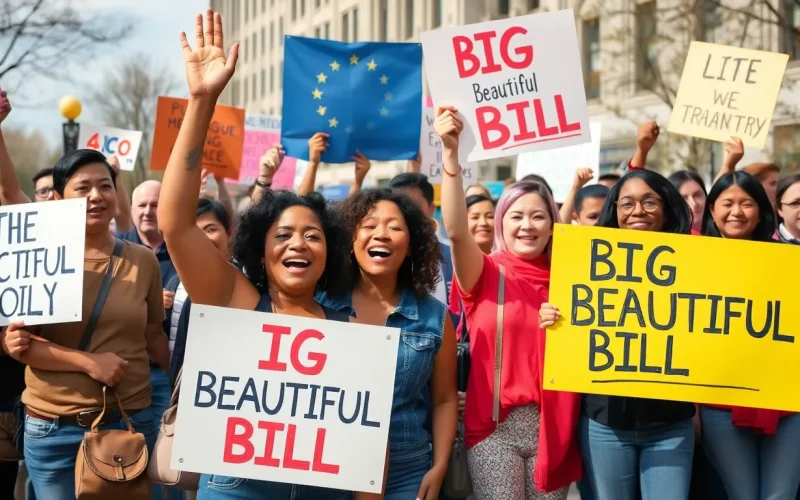Table of Contents
ToggleIn a world where size often matters, the “Big Beautiful Bill” has captured attention like a cat in a room full of laser pointers. With its promise to reshape policies and boost economic growth, this bill has supporters buzzing with excitement. But has it actually passed?
Overview Of The Big Beautiful Bill
The “Big Beautiful Bill” represents a significant legislative effort aimed at reforming multiple sectors, including healthcare and infrastructure. It’s designed to enhance economic stability while addressing pressing social issues. Proponents view it as a crucial step toward modernizing outdated systems and promoting sustainability.
Supporters highlight key features such as increased funding for education, affordable healthcare initiatives, and comprehensive infrastructure improvements. Specific allocations include billions earmarked for renewable energy projects, which aim to reduce reliance on fossil fuels. Additionally, the bill proposes tax incentives to stimulate job creation within underserved communities.
Opponents express concerns regarding potential budget deficits and the overall financial impact. They argue that the projected costs may outweigh benefits, creating long-term economic challenges. Discussions continue to reflect various political perspectives, with debates centering on fiscal responsibility versus the necessity for transformative change.
The current status remains uncertain, as lawmakers engage in negotiations to refine its provisions. Various amendments are under consideration to address diverse constituencies’ concerns while maintaining the bill’s core objectives. Observers emphasize the importance of this legislation in shaping future policymaking decisions.
Future implications of the “Big Beautiful Bill” may include shifts in public opinion regarding government intervention in economic matters. As debates evolve, the outcome of this legislation could significantly influence the political landscape and set precedents for future initiatives.
Key Provisions Of The Bill

The “Big Beautiful Bill” includes several key provisions aimed at economic stability and social reform. Focused on transformative change, these provisions impact a variety of sectors.
Economic Impact
Funding for education sees a significant increase, promoting advancements in the workforce. Investments in infrastructure promise to create numerous jobs across multiple industries. Billions allocated for renewable energy initiatives aim to drive innovation while reducing dependency on fossil fuels. Tax incentives target job creation in underserved communities, intending to uplift economic conditions. Supporters argue these measures will enhance overall productivity and stimulate long-term growth.
Social Implications
Affordable healthcare initiatives address access to essential services for vulnerable populations. Increasing funding for social programs seeks to alleviate poverty and improve quality of life. Extensive infrastructure improvements enhance public transportation, connecting residents to job opportunities. Proponents highlight how these changes could lead to better health outcomes and community cohesion. Overall, the bill’s social implications underline a commitment to equality and sustainability in policymaking.
The Legislative Process
The legislative process for the “Big Beautiful Bill” involves several essential stages. Lawmakers must navigate through committees, debates, and votes to bring the bill to fruition.
Timeline Of The Bill
Introduced in early 2023, the bill quickly garnered bipartisan attention. Significant discussions occurred during the spring session, culminating in committee hearings that allowed stakeholders to voice their opinions. By the summer, amendments were proposed to fine-tune its provisions. A key vote in the House occurred in late September, where discussions shifted toward strategic negotiations. Following continued deliberations, the Senate plans to release a revised outline by the end of 2023.
Key Advocates And Opponents
Support for the bill comes from various sectors, including labor unions, education groups, and progressive organizations. Advocates argue the measure will spur economic growth and provide vital social services. Prominent figures in Congress have voiced endorsements, highlighting its potential benefits for communities. In contrast, opposition arises from fiscal conservatives and certain business organizations, who raise concerns about budget deficits. Critics warn that the overall financial ramifications could hinder long-term economic stability. Ongoing dialogues reflect a range of perspectives, influencing the bill’s trajectory through the legislative process.
Current Status Of The Bill
The “Big Beautiful Bill” is currently undergoing significant legislative scrutiny. Introduced in early 2023, it has progressed through initial committee evaluations and public discussions. Following these stages, a crucial vote in the House took place in late September 2023.
Amendments proposed during summer refined its provisions, addressing various stakeholder concerns. With bipartisan interest, stakeholders from labor unions, education groups, and progressive organizations continue to advocate for its passage. This varied support highlights the bill’s perceived potential to drive economic growth and enhance social services.
Conversely, fiscal conservatives and certain business groups have raised objections. They express worries about potential budget deficits arising from the bill’s projected costs. Concerns about financial implications continue to influence ongoing discussions in Congress.
Looking ahead, the Senate aims to release a revised outline by the end of 2023. The discussions reflect a complex balance between recommending transformative policy changes and addressing fiscal responsibility, impacting the bill’s trajectory. Observers expect ongoing negotiations will shape the final outcome, keeping the focus on ensuring the bill meets diverse needs while mitigating economic risks.
The fate of the “Big Beautiful Bill” remains uncertain as it navigates the complexities of legislative scrutiny. With strong support from various advocacy groups and ongoing debates among lawmakers, its potential to reshape critical sectors is evident. However, concerns about budget deficits and financial sustainability continue to pose challenges.
As discussions progress and amendments are introduced, the outcome will significantly impact economic growth and social services. Stakeholders from all sides are closely monitoring developments, knowing that the decisions made now could influence future policymaking and public sentiment. The trajectory of this bill will be a defining moment in addressing the balance between transformative change and fiscal responsibility.





